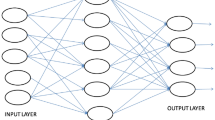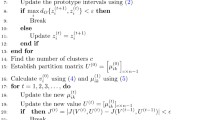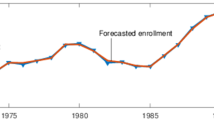Abstract
Time series forecasting is of great interest to managers and scientists because of the numerous benefits it offers. This study proposes three main improvements for forecasting to time series. First, we establish the percentage variation series between two consecutive times and use an automatic algorithm to divide it into clusters with a suitable number. This algorithm also determines the specific elements in each cluster. Second, a new fuzzy function with a normal type is built for each cluster. Finally, we develop the forecasting rule based on the previous two improvements. By combining these enhancements, we obtain an effective model for forecasting. The proposed model is presented step-by-step and executed rapidly using the MATLAB procedure. Compared to many models tested on the M3-Competition set with 3003 series and the M4-Competition set with 100,000 series, the proposed model obtains outstanding results. It also achieves competitive results when compared to existing models across several benchmarks and real series.




Similar content being viewed by others
References
Abbasov AM, Mamedova MH (2003) Application of fuzzy time series to population forecasting. Vienna Univ Technol 12:545–552
Abreu PH, Silva DC, Moreira JM, Reis LP, Garganta J (2013) Using multivariate adaptive regression splines in the construction of simulated soccer team’s behavior models. Int J Comput Intell 6(5):893–910
Aladag S, Aladag CH, Mentes T, Egrioglu E (2012) A new seasonal fuzzy time series method base on the multiplicative neuron model and SARIMA. Hacet J Math Stat 41(3):337–345
Alyousifi Y, Othman M, Almohammedi AA (2012) A Novel stochastic fuzzy time series forecasting model based on a new partition method. IEEE Access 9:80236–80252
Alyousifi Y, Othman M, Husin A, Rathnayake U (2021) A new hybrid fuzzy time series model with an application to predict PM10 concentration. Ecotoxicol Environ Saf 227:112875
Cai Q, Zhang D, Zheng W, Leung SCH (2015) A new fuzzy time series forecasting model combined with ant colony optimization and auto-regression. Knowl-Based Syst 74:61–68
Chen SM (1996) Forecasting enrollments based on fuzzy time series. Fuzzy Sets Syst 81(3):311–319
Chen SM (2002) Forecasting enrollments based on high-order fuzzy time series. Fuzzy Sets Syst 33(1):1–16
Chen SM, Hsu CC (2004) A new method to forecast enrollments using fuzzy time series. Int J Appl Sci Eng 2(3):234–244
Chen SM, Kao PY (2013) Taifex forecasting based on fuzzy time series particle swarm optimization techniques and support vector machines. Inf Sci 247:62–71
Chen LS, Chen MY, Chang JR, Yu PY (2021) An intuitionistic fuzzy time series model based on new data transformation method. Int J Comput Intell Syst 14(1):550–559
Cheng SH, Chen SM, Jian WS (2016) Fuzzy time series forecasting based on fuzzy logical relationships and similarity measures. Inf Sci 327:272–287
De Lima Silva PC, Sadaei HJ, Ballini R, Guimarães FG (2020) Probabilistic forecasting with fuzzy time series. IEEE Trans Fuzzy Syst 28(8):1771–1784
Egrioglu E, Aladag CH, Yolcu U, Uslu VR, Basaran MA (2010) Finding an optimal interval length in high order fuzzy time series. Expert Syst Appl 37:5052–5055
Egrioglu E, Aladag CH, Yolcu U, Uslu VR, Erilli NA (2011) Fuzzy time series forecasting method based on Gustafson-Kessel fuzzy clustering. Expert Syst Appl 38(8):10355–10357
Egrioglu V, Bas E, Aladag CH, Yolcu U (2016) Probabilistic fuzzy time series method based on artificial neural network. Am J Intell Syst 62:42–47
Garg B, Garg R (2016) Enhanced accuracy of fuzzy time series model using ordered weighted aggregation. Appl Soft Comput 48:265–280
Ghosh H, Chowdhury S, Prajneshu S (2016) An improved fuzzy time-series method of forecasting based on L-R fuzzy sets and its application. J Appl Stat 43(6):1128–1139
Gupta KK, Kumar S (2019) A novel high-order fuzzy time series forecasting method based on probabilistic fuzzy sets. Granul Comput 4:699–713
Huarng K (2001) Heuristic models of fuzzy time series for forecasting. Fuzzy Sets Syst 123(3):369–386
Huarng K, Yu THK (2006) Ratio-based lengths of intervals to improve fuzzy time series forecasting. IEEE Trans Syst Man Cybern Part B Cybern 36(2):328–340
Kuo IH, Horng SJ, Kao TW, Lin TL, Lee CL, Pan Y (2009) An improved method for forecasting enrollments based on fuzzy time series and particle swarm optimization. Expert Syst Appl 36:6108–6117
Lee HS, Chou MT (2004) Fuzzy forecasting based on fuzzy time series. Int J Comput Math 81(7):781–789
Lee LW, Wang LH, Chen SM (2008) Temperature prediction and TAIFEX forecasting based on high-order fuzzy logical relationships and genetic simulated annealing techniques. Expert Syst Appl 34(1):328–336
Li ST, Cheng YC, Lin SY (2008) A FCM-based deterministic forecasting model for fuzzy time series. Comput Math Appl 56:3052–3063
Makridakis S, Hibon M (2000) The M3-competition: conclusions and implications. Int J Forecast 16(4):451–476
Makridakis S, Spiliotis E, Assimakopoulos V (2020) The M4 competition: 100,000 time series and 61 forecasting methods. Int J Forecast 36(1):54–74
Ngoc HC, Huynh LN, Thihong DN, Van TV (2022) Building the forecasting model for time series based on the improved fuzzy relationship for variation of data. Int J Comput Intell Appl 21(4):2250026
Own CM, Yu PT (2005) Forecasting fuzzy time series on a heuristic high-order model. Cybern Syst Int J 36(7):705–717
Phamtoan D, Vovan T (2021) Building fuzzy time series model from unsupervised learning technique and genetic algorithm. Neural Comput Appl. https://doi.org/10.1007/s00521-021-06485-7
Singh SR (2007) A simple method of forecasting based on fuzzy time series. Appl Math Comput 186(1):330–339
Singh P, Borah B (2013) High-order fuzzy-neuro expert system for time series forecasting. Knowl-Based Syst 46:12–21
Singh P (2020) A novel hybrid time series forecasting model based on neutrosophic-PSO approach. Int J Mach Learn Cybern 11:1643–1658
Singh P (2021) FQTSFM: a fuzzy-quantum time series forecasting model. Inf Sci 566:57–79
Song Q, Chissom BS (1993) Forecasting enrollments with fuzzy time series-Part I. Fuzzy Sets Syst 54(3):269–277
Song Q, Chissom BS (1994) Forecasting enrolments with fuzzy time series-Part II. Fuzzy Sets Syst 62(1):1–8
Swain S, Nandi S, Patel P (2018) Development of an ARIMA model for monthly rainfall forecasting over khordha district. Adv Intell Syst Comput 708:325–331
Sulandari W, Subanarb S, Lee MH, Rodrigues PC (2020) Time series forecasting using singular spectrum analysis, fuzzy systems and neural networks. MethodsX 7:101015
Tinh NV (2020) Enhanced forecasting accuracy of fuzzy time series model based on combined fuzzy C-mean clustering with particle swam optimization. Int J Comput Intell Appl 19(2):1–26
Teoh HJ, Cheng CH, Chu HH, Chen JS (2008) Fuzzy time series model based on probabilistic approach and rough set rule induction for empirical research in stock markets. Data Knowl Eng 67(1):103–117
Vovan T (2019) An improved fuzzy time series forecasting model using variations of data. Fuzzy Optim Decis Making 18(2):151–173
Vovan T, Ledai N (2019) A new fuzzy time series model based on cluster analysis problem. Int J Fuzzy Syst 21(3):852–864
Vovan T, Lethithu T (2020) A fuzzy time series model based on improved fuzzy function and cluster analysis problem. Commun Math Stat 10:51–66
Vovan T, Nguyenhuynh L, Lethithu T (2021) A forecasting model for time series based on improvements from fuzzy clustering problem. Ann Oper Res 312:473–493
Wang W, Liu X (2015) Fuzzy forecasting based on automatic clustering and axiomatic fuzzy set classification. Inf Sci 294:78–94
Wang NY, Chen SM (2009) Temperature prediction and TAIFEX forecasting based on automatic clustering techniques and two-factors high-order fuzzy time series. Expert Syst Appl 36(2):2143–2154
Wu H, Long H, Jiang J (2019) Handling forecasting problems based on fuzzy time series model and model error learning. Appl Soft Comput 78:109–118
Wu H, Long H, Wang Y, Wang Y (2021) Stock index forecasting: a new fuzzy time series forecasting method. J Forecast 40(4):653–666
Ye F, Zhang L, Zhang D, Zhang D, Fujita H, Gong Z (2016) A novel forecasting method based on multi-order fuzzy time series and technical analysis. Inf Sci 367–368:41–47
Yolcu OC, Lam HK (2017) A combined robust fuzzy time series method for prediction of time series. Neurocomputing 247:87–101
Yu HK, Huarng K (2010) A neural network-based fuzzy time series model to improve forecasting. Expert Syst Appl 37:3366–3372
Yu L, Wang S, Lai KK, Nakamori Y (2005) Time series forecasting with multiple candidate models: selecting or combining. J Syst Sci Complex 18(1):1–18
Yusuf SM, Mohammad A, Hamisu AA (2017) A novel two-factor high order fuzzy time series with applications to temperature and futures exchange forecasting. Niger J Technol 36(4):1124–1134
Zhang Y, Qu H, Wang W, Zhao J (2020) A Novel fuzzy time series forecasting model based on multiple linear regression and time series clustering. Math Probl Eng 2020:9546792
Acknowledgements
This research is funded by Ministry of Education and Training in Vietnam under grant number B2023-TCT-06.
Author information
Authors and Affiliations
Contributions
Luan Nguyen-Huynh: Establish for the Matlab procedure for the proposed model, and perform the numerical examples and applications Tai Vo-Van: build the proposed model and write the manuscript.
Corresponding author
Ethics declarations
Conflict of interest
The authors declare that they have no conflict of interest.
Additional information
Publisher's Note
Springer Nature remains neutral with regard to jurisdictional claims in published maps and institutional affiliations.
Rights and permissions
Springer Nature or its licensor (e.g. a society or other partner) holds exclusive rights to this article under a publishing agreement with the author(s) or other rightsholder(s); author self-archiving of the accepted manuscript version of this article is solely governed by the terms of such publishing agreement and applicable law.
About this article
Cite this article
Nguyen-Huynh, L., Vo-Van, T. A new fuzzy time series forecasting model based on clustering technique and normal fuzzy function. Knowl Inf Syst 65, 3489–3509 (2023). https://doi.org/10.1007/s10115-023-01875-w
Received:
Revised:
Accepted:
Published:
Issue Date:
DOI: https://doi.org/10.1007/s10115-023-01875-w




